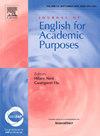汉英研究文章结语部分:跨语言研究
IF 3.4
1区 文学
Q1 EDUCATION & EDUCATIONAL RESEARCH
引用次数: 0
摘要
本研究考察了英汉研究型文章结语部分的修辞结构、立场标记的使用以及动位连接特征。该分析是基于在四个软学科(即应用语言学、经济学、心理学和社会学)的国际英文期刊和本地中文期刊上发表的360个RAs的两个语料库。结果表明,中英文RA结论的步数分布相似,但在步数频率和步数分布上存在差异。两种语料库在立场标记的使用上存在显著差异,英语RA结论中立场标记的使用较为密集。中文作家倾向于使用助推器和态度标记,而英文作家则倾向于使用模糊限制语和自我提及。重要的是,尽管确定了跨动作和步骤的姿态标记部署的变化,但发现了特定的动作-姿态连接模式。这一研究结果具有重要的理论和教学意义,它揭示了动作/步骤中姿态标记分布的趋同和差异,并加深了新手作者对动作/步骤中修辞手段和不同能力对成功学术写作的重要性的认识。本文章由计算机程序翻译,如有差异,请以英文原文为准。
Move-stance connection in Chinese and English research article conclusion sections: A cross-linguistic study
This study investigates the rhetorical structures of Chinese and English research article (RA) conclusion sections, the use of stance markers, and the move-stance connection features. The analysis is based on two corpora of 360 RAs published in international English journals and local Chinese journals in four soft disciplines (i.e., Applied Linguistics, Economics, Psychology and Sociology). Results show that both Chinese and English RA conclusions have similar distributions of moves, but there are differences in the frequencies of moves and distributions of steps. Remarkable distinctions were identified in the use of stance markers between the two corpora, with dense use of stance markers in English RA conclusions. Chinese writers tend to utilize boosters and attitude markers, while English writers prefer to employ hedges and self-mentions. Importantly, notwithstanding the identified variations in the deployment of stance markers across moves and steps, a specific move-stance connection pattern was found. The findings have both theoretical and pedagogical implications in the way of proposing the move-stance connection in RA conclusions, underscoring the convergence and divergence in the distributions of stance markers in moves/steps, and deepening novice writers’ awareness of the rhetorical devices in RAs and the importance of different competencies necessary for successful academic writing.
求助全文
通过发布文献求助,成功后即可免费获取论文全文。
去求助
来源期刊

Journal of English for Academic Purposes
Multiple-
CiteScore
6.60
自引率
13.30%
发文量
81
审稿时长
57 days
期刊介绍:
The Journal of English for Academic Purposes provides a forum for the dissemination of information and views which enables practitioners of and researchers in EAP to keep current with developments in their field and to contribute to its continued updating. JEAP publishes articles, book reviews, conference reports, and academic exchanges in the linguistic, sociolinguistic and psycholinguistic description of English as it occurs in the contexts of academic study and scholarly exchange itself.
 求助内容:
求助内容: 应助结果提醒方式:
应助结果提醒方式:


